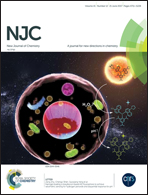Highly selective ratiometric fluorescent probe based on diketopyrrolopyrrole for Au3+: an experimental and theoretical study†
Abstract
A diketopyrrolopyrrole-based fluorescent probe 1 was explored as a ratiometric probe for selective detection of Au3+, with the detection limit of 18 nM. The probe displayed an absorption maximum at 528 nm and a strong red fluorescence at 610 nm. In the presence of Au3+, the absorption and emission band blueshifted to 488 and 555 nm, respectively. Correspondingly, the color of the probe solution changed from orange to flesh color, and the fluorescence changed from orange to yellow-green. NMR and HRMS spectral analysis demonstrated that the selective ratiometric fluorescence response of probe 1 with Au3+ involved a selective Au3+-mediated hydrolyzation and oxidization reactions using a catalytic amount of Au3+. In addition, the ratiometric response of probe 1 was rationalized by DFT and TDDFT calculations.



 Please wait while we load your content...
Please wait while we load your content...